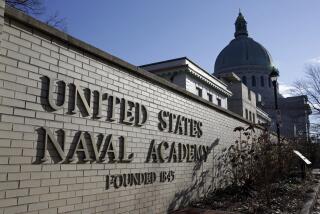College Binge Drinking Soars, Study Finds : Alcohol: The number of female abusers is found to have risen significantly. Panel recommends a campaign to deglamorize campus consumption.
- Share via
WASHINGTON — America’s colleges are witnessing a “startling” increase in binge drinking, particularly among women, and as many as one in three students qualify as alcohol abusers, according to a study released Tuesday by a Columbia University panel.
Noting that widespread drinking leads to violence, vandalism and declining academic performance, the report issued by Columbia’s Center on Addiction and Substance Abuse calls for campus campaigns to deglamorize alcohol.
Alcohol abuse is rampant on campuses across the country, even though about three-fourths of college students are below the legal drinking age, the report notes.
The percentage of college women who deliberately consume enough alcohol to get drunk has soared from 10% in 1977 to 35% last year, according to the study, conducted by the Center’s Commission on Substance Abuse at Colleges and Universities.
Binge drinking--defined as the consumption of more than five cans of beer or five glasses of wine at a single sitting--is practiced by 50% of all students. Among college women, the percentage has increased from 14% to 37% over the last 15 years, the study says.
Women drinkers are more at risk than their male counterparts because sex-based differences in metabolism tend to cause them to become intoxicated after drinking smaller quantities of alcohol.
“Once thought of as a male rite of passage, alcohol abuse has now become a woman’s rite of passage,” said Pamela Ann Rymer, a federal appeals court judge and a member of the Columbia commission. “Yet drinking to get drunk . . . can destroy the lives of the best and the brightest of our young women.”
“This prevalence of binge drinking has devastating consequences,” added Father Edward A. Malloy, president of the University of Notre Dame and chairman of the commission.
An estimated 90% of all campus rapes involve drinking on the part of the assailant, the victim, or both, the report says. And some 60% of women who contract sexually transmitted diseases, including AIDS, are under the influence of alcohol when they have intercourse.
Center President Joseph A. Califano Jr. said that young women feel more pressure today to compete with men, even in self-destructive activities such as drinking. “It’s the worst aspect of the macho world,” he said.
College students spend an estimated $5.5 billion a year on beer, wine and liquor--more than their combined outlays for books and all other beverages, the report says. On a typical campus, per capita student spending on alcohol is $446 a year.
The study indicated that collegians tend to drink more than young people who do not attend college. For example, 42% of college students reported that they had engaged in binge drinking at some point during the preceding two weeks, compared to 33% of non-college youth.
White male college students were the heaviest drinkers, averaging nine drinks per week, or roughly twice the amount consumed by white females. Black students on predominantly white schools drank far less, the study indicates.
Academically, alcohol is a downer, the study reported: 40% of students with academic problems drink too much and alcohol is a factor in 28% of dropout cases.
“Alcohol . . . is a stumbling block to academic success,” said Malloy. “We must recognize that alcohol abuse is a debilitating, not a liberating, experience and we must work together to deglamorize it.”
The commission proposed a series of steps to change campus attitudes about alcohol abuse, including increased education on the problem and coordinated strategies involving faculty, alumni, parents and students.
It suggested a national “Alcohol Awareness Index” to rate colleges and universities on how well they address alcohol problems. The index would be published in college catalogues and national college guides.
The panel advocated a ban on alcohol-related advertising and promotions, along with strict regulation of drinking at campus functions. It called for a change in the Campus Security Act of 1990 to require that crime reports specify if alcohol abuse was involved.
More to Read
Sign up for Essential California
The most important California stories and recommendations in your inbox every morning.
You may occasionally receive promotional content from the Los Angeles Times.













